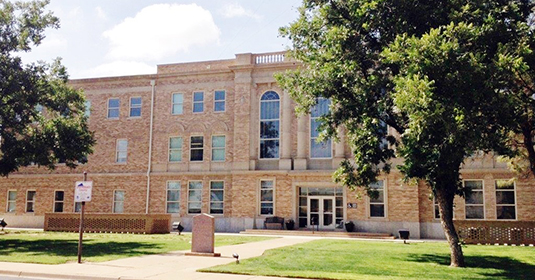County:
 Located on the southern High Plains of West Texas, the area in and around Terry County served as the original hunting ground for the Comanches and other Indians in search of buffalo.
Located on the southern High Plains of West Texas, the area in and around Terry County served as the original hunting ground for the Comanches and other Indians in search of buffalo.
Terry County has some 170,000 acres under irrigation, with cotton as the principal crop. In fact, the county is one of the state leaders in cotton production, and also one of the state’s top peanut producers.
The county houses several unique attractions including the original jail, erected in 1916, and the A.M. Brownfield Home, a Recorded Texas Historic Landmark and home of the Terry County Heritage Museum. The home was built in 1928 and displays the influences of Spanish Colonial style architecture. Among the unique exhibits, the museum offers a display of antique quilts and history on the popular card game “Skip-Bo,” which was invented in Brownfield.
Visitors and homefolks frequent area parks including Hamilton Park, which provides an educational tour of the county’s history and the future of education; Coleman RV Park and its free amenities; and Terry County Park, the largest in the county offering an indoor meeting hall, baseball field, playground, tables, swimming pool, tennis court, and basketball court. The county is especially proud of the Brownfield Aquatic Center featuring a double slide, miniature lazy river, diving board, and special activity lanes.
Gillham Park and Powell Lake comprise the second-largest park in the area, complete with three large ponds; Judge Rhyne Trails Park includes a pond and circular walking track.
Terry County is home to the first Quilt Trail in Texas, with 10 signs painted with popular quilt squares placed throughout the county. For example, a quilt block welcomes visitors to Meadow, the hometown of Sonny Curtis.
Special annual events include the Harvest Festival in October and the Brisket and Bean Cook-Off every April.
Courthouse:
The Terry County Courthouse was originally designed by noted architects Peters and Haynes in 1925. A major addition, effectively doubling the size of the courthouse, was designed in 1951 by Carl H. Stantz.
In 2012, a renovation/restoration was designed by Albert Moffitt, partner and senior architect at Grimes and Associates, Architects and Engineers. In addition to architecture and engineering design, Grimes and Associates also provided construction management services. The cost of the recent work was $3.9 million.
The exterior façade was restored to historic appearance with the installation of new windows. The windows, which match the original configuration, are energy efficient double pane units. Close coordination with the Texas Historic Commission’s Lyman Labre ensured the white color that was selected matched archived photographs.
The district courtroom was also returned to its original prominence by removing a non-historic lay-in ceiling. To ensure good acoustic qualities, the original plaster ceiling was removed and replaced with sound-absorbing plaster.
One of the delightful surprises during the restoration of the courtroom was the discovery of marble flooring which had been covered with carpet. The historic marble was polished, and a plethora of old/abandoned anchors were removed. The discovery of the marble in the courtroom was the catalyst to install marble at the floor and wainscot in the 1951-addition main corridor.
Another exciting discovery in the courtroom was finding the outline of the historic door pediments on the walls above the lay-in ceiling. Research into the 1925 blueprints revealed the original construction drawings for these components. These historic drawings were then reused to rebuild and install these pediments.
Another significant upgrade was enlarging the elevator to accessible standards. The new elevator was installed in the same general location as the 1951 drawings, except it was extended so that it travels to the basement and third floor. This one item may have been the most vexing aspect of the entire project.
The fire safety of the building was significantly enhanced with the installation of a fire sprinkler and fire alarm systems.
The building received a complete new electrical system, high efficiency HVAC equipment, energy efficient lighting, programmable energy management system, accessible courtroom sound system, all new plumbing, accessible toilets, and high speed data wiring throughout.
The county reoccupied the courthouse in late spring 2013.H – Information provided by Grimes and Associates.















